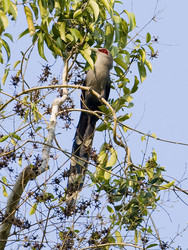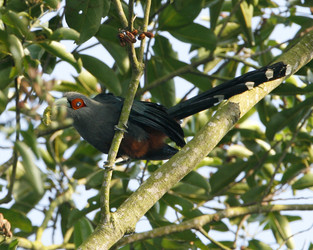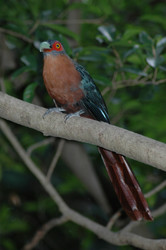Phaenicophaeus



This tree diagram shows the relationships between several groups of organisms.
The root of the current tree connects the organisms featured in this tree to their containing group and the rest of the Tree of Life. The basal branching point in the tree represents the ancestor of the other groups in the tree. This ancestor diversified over time into several descendent subgroups, which are represented as internal nodes and terminal taxa to the right.

You can click on the root to travel down the Tree of Life all the way to the root of all Life, and you can click on the names of descendent subgroups to travel up the Tree of Life all the way to individual species.
For more information on ToL tree formatting, please see Interpreting the Tree or Classification. To learn more about phylogenetic trees, please visit our Phylogenetic Biology pages.
close boxReferences
Sorenson, M.D. and R.B. Payne. 2005. Molecular systematics: cuckoo phylogeny inferred from mitochondrial DNA sequences. Pp. 68-94 in R.B. Payne. Bird Families of the World: Cuckoos. Oxford University Press.
Title Illustrations

| Scientific Name | Phaenicophaeus tristis |
|---|---|
| Location | Kaeng Krachan, Thailand |
| Specimen Condition | Live Specimen |
| Source | Green-billed Malkoha - Phenicophaeus Tristis - Phenicophaeus |
| Source Collection | Flickr |
| Image Use |
 This media file is licensed under the Creative Commons Attribution-NonCommercial-NoDerivs License - Version 2.0. This media file is licensed under the Creative Commons Attribution-NonCommercial-NoDerivs License - Version 2.0.
|
| Copyright | © 2008 Mike Gillam |
| Scientific Name | Phaenicophaeus sumatranus |
|---|---|
| Location | Sime Forest, Singapore |
| Specimen Condition | Live Specimen |
| Life Cycle Stage | adult |
| Source | Chestnut-bellied Malkoha, Phaenicophaeus sumatranus, adult |
| Source Collection | Flickr |
| Image Use |
 This media file is licensed under the Creative Commons Attribution-NonCommercial-NoDerivs License - Version 2.0. This media file is licensed under the Creative Commons Attribution-NonCommercial-NoDerivs License - Version 2.0.
|
| Copyright | © 2007 Lip Kee Yap |
| Scientific Name | Phaenicophaeus curvirostris |
|---|---|
| Location | captive |
| Specimen Condition | Live Specimen |
| Sex | Female |
| Source | chestnut breasted malkoha (Phaenicophaeus curvirostris) |
| Source Collection | Flickr |
| Image Use |
 This media file is licensed under the Creative Commons Attribution-NonCommercial-NoDerivs License - Version 2.0. This media file is licensed under the Creative Commons Attribution-NonCommercial-NoDerivs License - Version 2.0.
|
| Copyright | © 2006 coracii |
About This Page
Page copyright © 2007
 Page: Tree of Life
Phaenicophaeus.
The TEXT of this page is licensed under the
Creative Commons Attribution-NonCommercial License - Version 3.0. Note that images and other media
featured on this page are each governed by their own license, and they may or may not be available
for reuse. Click on an image or a media link to access the media data window, which provides the
relevant licensing information. For the general terms and conditions of ToL material reuse and
redistribution, please see the Tree of Life Copyright
Policies.
Page: Tree of Life
Phaenicophaeus.
The TEXT of this page is licensed under the
Creative Commons Attribution-NonCommercial License - Version 3.0. Note that images and other media
featured on this page are each governed by their own license, and they may or may not be available
for reuse. Click on an image or a media link to access the media data window, which provides the
relevant licensing information. For the general terms and conditions of ToL material reuse and
redistribution, please see the Tree of Life Copyright
Policies.
- First online 28 August 2007
- Content changed 28 August 2007
Citing this page:
Tree of Life Web Project. 2007. Phaenicophaeus. Version 28 August 2007 (temporary). http://tolweb.org/Phaenicophaeus/91962/2007.08.28 in The Tree of Life Web Project, http://tolweb.org/











 Go to quick links
Go to quick search
Go to navigation for this section of the ToL site
Go to detailed links for the ToL site
Go to quick links
Go to quick search
Go to navigation for this section of the ToL site
Go to detailed links for the ToL site